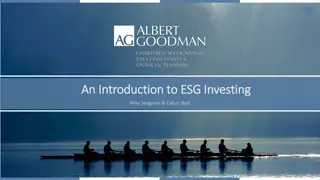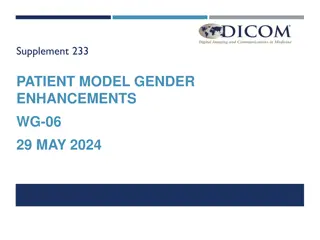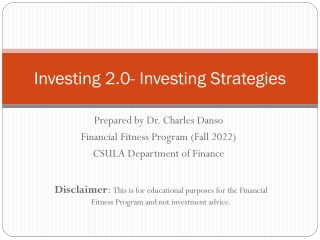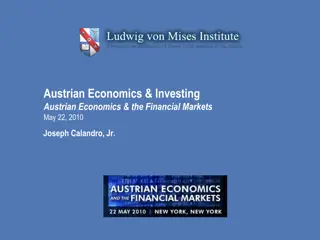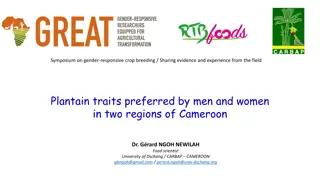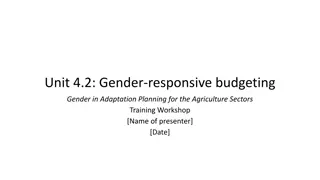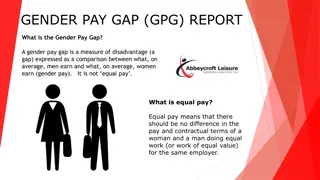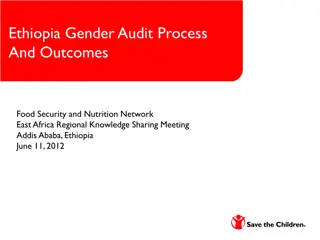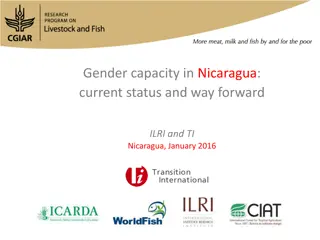Understanding Gender Differences and Decision-Making in Investing
The physiology of investing explores how gender differences, such as risk aversion, impact financial decisions. Factors like culture, biology, and early experiences influence attitudes towards risk. The debate of nature versus nurture in decision-making involves studying twins, hormones, and social environments to understand how our physiology influences financial choices. Exploring psychobiology and gender stereotypes sheds light on the varying risk attitudes between men and women in investment settings.
Download Presentation

Please find below an Image/Link to download the presentation.
The content on the website is provided AS IS for your information and personal use only. It may not be sold, licensed, or shared on other websites without obtaining consent from the author. Download presentation by click this link. If you encounter any issues during the download, it is possible that the publisher has removed the file from their server.
E N D
Presentation Transcript
Chapter 12 Physiology of Investing
Psychobiology The branch of psychology that studies the biological foundations of behavior, emotions, and mental processes. The American Heritage Medical Dictionary 2
Gender Women are more risk averse than men Women are also under-represented in the finance industry For federal government workers in the Thrift Savings Plan, women invest their pension assets more conservatively Married women invest a smaller proportion of their portfolio in stocks than married men Women are more risk averse than men in lab settings and in investment decisions in their lives Being more financially risk averse means that women take less risk in their investment portfolios Note that taking less financial risk will result in lower returns and a smaller portfolio value Thus, a gender risk gap will lead to a gender wealth gap over time 3
Are gender differences due to culture, early life experiences, or some innate differences in characteristics like risk attitudes? A lottery type experiment was conducted with students from coed schools and same-sex schools The level of risk aversion was found to be: girls at coed schools (highest) girls at same-sex schools boys at coed schools boys at same-sex schools (lowest) Less social interaction with boys results in girls taking more financial risk Some of the risk aversion gender differences may be gender- stereotype learned behavior Some may be biology 4
Nature versus Nurture Our decision-making is influenced by our experiences, education, cognitive process, and social environment But is also driven by our physiology? What can we learn from twins, hormones, neuroeconomics, etc.? 5
Twins Identical Twins (monozygotic twins) One fertilized egg splits into two Share 100% of their genetic composition Fraternal Twins (dizygotic twins) Two eggs each fertilized separately Share 50% of their genetic composition, on average 6
Twin Investment Study Swedish Twin Registry 37,504 twins Swedish Tax Agency Until 2006, required to report assets (1.5% wealth tax) Investment data 10,842 identical 26,662 fraternal Opposite gender: 14,252 Same gender: 12,410 Objective: Compare the investments of identical twins, fraternal twins (same and different genders), random matches 1. Participation in the stock market 2. Proportion of portfolio in the stock market 3. Level of portfolio risk 7
Proportion Explained by Genetics Invested in the Stock Market Identical Twins Fraternal Twins Fraternal Twins-Different Gender Fraternal Twins-Same Gender Twin with Random Match 0 0.05 0.1 0.15 0.2 0.25 0.3 0.35 Correlation Proportion of Portfolio in the Stock Market Portfolio Risk Identical Twins Identical Twins Fraternal Twins Fraternal Twins Fraternal Twins-Different Gender Fraternal Twins-Different Gender Fraternal Twins-Same Gender Fraternal Twins-Same Gender Twin with Random Match Twin with Random Match 0 0.05 0.1 0.15 0.2 0.25 0.3 0.35 Correlations 0 0.1 0.2 Correlation 0.3 0.4 0.5 8 Amir Barnea, Henrik Cronqvist, and Stephan Siegel, Nature or Nurture: What Determines Investor Behavior? Journal of Financial Economics 98(2010): 583 604.
Study Conclusions Regression analysis can control for the level of wealth, education, age, etc. Portion of investment behavior explained by genetics: Sample Share of Equities 29.0% 44.5% 19.2% 29.1% 22.4% 38.5% Overall Results Age < 30 30 < Age < 55 Men Women Twins reared apart 9
Choosing Investment Funds a field experiment Prior to 2000, the Swedish Premium Pension Agency handled the investing decisions of mandatory individual retirement accounts. A nationwide experiment! In 2000, people could choose how to invest their accounts from a menu of nearly 500 funds. Choose up to five funds Funds were color coded by risk level 68% of the eligible Swedes made an active decision, the rest passively took the default option Merge this data with the Twin Registry Measurements: Made Active Choice, Risk level, Chose Ethical Funds, Exhibited Return Extrapolation Bias 10
Twins and Behavioral Biases Survey Evidence Swedish twins where sent an extensive questionnaire. Over 11,000 completed he survey, but often only one twin completed it. 1,150 identical twin pairs, 2,362 fraternal pairs (7,024 total people) Representativeness Bias 3 questions on likelihood people belong to groups Sunk Cost Going to show after lost the ticket Illusion of Control Discount acceptable to choose own numbers in lottery Status Quo Bias (Default bias) 3 questions on having switched to cheaper services Procrastination How often late paying bills Time Impatient 3 questions on the discount to receive money sooner Loss Aversion 3 lottery questions 11
Behavioral anomalies are moderately heritable Behavioral Biases Explained by Genetics Representativeness Bias Sunk Cost Bias Illusion of Control Status Quo Bias Procrastination Time Impatient Loss Aversion 0% 5% 10% 15% 20% 25% 30% 35% 40% 45% Genetic differences explain one-fifth to one-third of individual variation Common environment accounts for only a small fraction of differences Non-shared environment explains a large portion of variation 12 David Cesarini, Magnus Johannesson, Patrik K. E. Magnusson, and Bj rn Wallace, 2012. The Behavioral Genetics of Behavioral Anomalies, Management Science 58(1), 21-34.
Risk and Giving lab experiments In another study, Swedish twins were invited to come into an experimental setting, play some common economic research games, and earning some money. 141 fraternal pairs, 319 identical pairs 920 total people Giving: Allocate $15 between themselves and a charity for the homeless. Risk, six decisions: Do you want $3 for certain, or a 50/50 gamble for $15? Do you want $4.50 for certain, or a 50/50 gamble for $15? Do you want $12 for certain, or a 50/50 gamble for $15? (one is randomly chosen and executed) 13
What Drives the Twins Decisions? Giving Risk Aversion 70% 80% Portion that explains the decisons Portion that explains the decision 70% 60% 60% 50% 50% 40% 40% 30% 30% 20% 20% 10% 10% 0% 0% Genetic Common Environment Unique Environment Genetic Common Environment Unique Environment A similar study using the Minnesota Twin registry and much fewer people, reports risk aversion decisions are 63% heritable, the balance being from unshared environment. David Cesarini, Christopher T. Dawes, Magnus Johannesson, Paul Lechtenstein, and Bjorn Wallace, 2009, Genetic Variation in Preferences for Giving and Risk Taking, Quarterly Journal of Economics 124(2), 809-842. Michael J. Zyphur, Jayanth Narayanan, Richard D. Arvey, Gordon Alexander, 2009. The Genetics of Economic Risk Preferences, Journal of Behavioral Decision Making 22(4), 367-377. 14
What about other studies on families? There is strong evidence of an intergenerational transmission of investment attitudes and risk aversion. However, they do not decompose that transmission into nature and nurture. There is some criticism that too much of the variation between identical twins and fraternal twins is attributed to genetics in twin studies. Identical twins communicate with each other more than fraternal twins Identical twins face similar expectations from parents, teachers, coaches, etc. 15
Adoptions A study attempts to decompose investment decisions into pre- birth (genetics) and post-birth (environment) effects by analyzing adoptees. Sweden maintains information on all adoptions, including, where possible, the identity of biological and adoptive parents. 3,185 adoptees -- over 2 million non-adopted control sample Compare adult adoptee s investment decisions to biological parent and adoptive parent decisions. Results Post-birth effects have twice the influence as pre-birth effects for participating in the stock market. Pre-birth effects have little impact on the portion of equities in the portfolio. Post-birth has four times the impact for volatility of portfolio. Overall, Post-birth effects seem to be similar to combined twin shared and unique environment. Pre-birth effects seem similar to twin genetic influence. 16 Sandra E. Black, Paul J. Devereux, Petter Lundborg, and Kaveh Majlesi, 2017. On the Origins of Risk-Taking in Financial Markets, Journal of Finance, forthcoming.
More Adoptions 2,265 Korean babies adopted by Norwegian parents. Financial data is available in Norway similar to Sweden. The purpose of this study is to examine the mechanisms for intergenerational transmission of wealth and risk aversion controlling for genetic similarities. Makes a strong case that the rearing environment has much influence on a child s future wealth accumulation and financial risk-taking. Use Korean-Norwegian adoptees and non-adoptee siblings to examine genetic contribution Stock Market Participation 13.7% 10.3% Risky Portion of Portfolio Financial Wealth Education Genetics Shared Environment Unique Environment -3.9% 20.8% 35.5% 12.5% 57.7% 11.1% 76.0% 83.1% 52.0% 31.2% 17 Andreas Fagereng, Magne Mogstad, and Marte R nning, 2015. Why Do Wealthy Parents Have Wealthy Children?, Norway Statistics Discussion Paper No. 813, October 21.
Hormones The major classes of hormones include amines (such as adrenalin and noradrenalin), pep tides and proteins (such as oxytocin and leptin) and steroids (such as testosterone, oestradiol and cortisol). I know of studies examining testosterone, cortisol, and oxytocin Focus on testosterone, the male hormone High levels of testosterone have been shown to be associated with riskier behavior in many social contexts. Therefore, it is likely that testosterone levels can impact financial decision- making. There are 2 times testosterone may be important to your decision Prenatal testosterone impacts brain formation and other aspects of body growth. Current active testosterone may impact risk preferences 18
Impacts of Prenatal Exposure to Testosterone Higher prenatal exposure for men leads to more masculine facial features. Higher facial width-to-height ratio indicates higher prenatal T Also, giving T to adolescents causes craniofacial growth More testosterone exposure suggest higher risk taking A study of facial masculinity of male CEOs Firms with CEO with more masculine features show: Greater financial misreporting (and thus higher SEC investigations) Greater insider trading Option backdating 19 Yuping Jia, Laurence Van Lent, and Yachang Zeng, 2014. Masculinity, Testosterone, and Financial Misreporting, Journal of Accounting Research 52(5), 1195-1246.
Second to Fourth Finger Ratio (2D:4D) The ratio between the length of the second and fourth fingers (2D:4D) is smaller for people that were exposed to higher prenatal testosterone One study surveys 152 participants (65 female) on three risky financial decisions using lottery questions. The subjects exposed to higher levels of prenatal testosterone are more willing to take financial risks. This occurred for both men and women. Another study follows 45 high frequency male traders from a trading floor in London. The 2D:4D ratio and the number of years of training, equally predicted the trader s 20-month trading profitability Ellen Garbarino, Robert Slonim, and Justin Sydnor, 2011. Digit Ratios (2D:4D) as Predictors of Risky Decision Making for Both Sexes, Journal of Risk and Uncertainty 42, 1-26. John M. Coates, Mark Gurnell, and Aldo Rustichini, 2009. Second-to-Fourth Digit Ratio Predicts Success among High-Frequency Financial Traders, Proceedings of the National Academy of Sciences 106(2), 623-628. 20
Twin Testosterone Transfer Hypothesis For opposite sex fraternal twins, the higher level of prenatal testosterone in the amniotic fluid from the male fetus increases the pre-birth testosterone exposure of the female fetus. Women tend to be more risk averse than men. This theory suggests the female twin of a female-male pair should take more financial risk than other women, all else equal. Swedish Twin Registry A study examines 9,410 females from opposite sex twin pairs and compares them to 9,093 females from same- sex twin pairs Allocates more of her financial assets to equity, Invests in a higher risk portfolio, as measured by return volatility, Allots a higher proportion to individual stocks relative to mutual funds More overconfidence More investment in lottery type stocks Henrik Cronqvist, Alessandro Previtero, Stephan Seigel, and Roderick E. White, 2016. The Fetal Origins Hypothesis in Finance: Prenatal Environment, the Gender Gap, and Investor Behavior, Review of Financial Studies 29(3), 739-786. 38.6% of the gender gap in the allocation to equity, 10% and 11% of the gap in portfolio volatility and allocation to individual stocks 21
Measuring Active Testosterone through Saliva In one study, they measure morning and afternoon testosterone levels in a small group (n=17) of male traders for eight consecutive business days under real working conditions. The authors find that traders achieve a significantly greater daily profitability on days when their morning testosterone level is above their overall median level over the course of the study. Another study examines the performance and salivary testosterone in subjects engaging in the Iowa Gambling Task. This Task provides monetary rewards and losses over 100 rounds to test the decision-making sensitivity to rewards and losses. In each round, the subject can draw from one of four decks of cards. Subjects learn the reward/loses distributions from observing the outcomes of each draw. The study shows that subjects with higher testosterone levels took greater risks (drew more from higher risk decks of cards) than lower testosterone subjects. John M. Coates and J. Herbert, 2008, Endogenous Steriods and Finaicial Risk Taking on a London Trading Floor, Proceedings of the National Academy of Sciences 105(16), 6167-6172. Steven J. Stanton, Scott H. Liening, and Oliver C. Schultheiss, 2011. Testosterone is Positively Associated with Risk Taking in the Iowa Gambling Task, Hormones and Behavior 59, 252-256. 22
Physiology Does financial decision-making effect the body? One study wired up 10 professional traders (foreign exchange and interest rate derivatives) to measure conditions like heart rate, blood pressure, respiration, skin temperature, skin conductance response, etc., during the trading day. These are known to measure the physical response of emotions. Are emotions present during high risk and uncertainty events? Periods of high volatility are associated with high blood pressure higher skin temperature greater skin conductance responses Lower experience traders exhibited higher physiological responses 23 Andrew W. Lo and Dmitry V. Repin, 2002. The Psychophysiology of Real-Time Financial Risk Processing, Journal of Cognitive Neuroscience 14(3), 323-339.
More Physiology The market s performance may cause positive or negative emotions (and the associated physical symptoms) in the general investment public. Consider that on Black Monday (October 19, 1987), the stock market declined 25%. On that day, hospital admission in California spiked over 5%. There was no reversal effect the next day when the market recovered half of its losses. Overall, scholars found a strong link between stock market crashes and California hospital admissions for anxiety, panic disorder, and major depression. The stock market can make you sick. 24 Joseph Engelberg and Christopher A. Parsons, 2016, Worrying about the Stock Market: Evidence from Hospital Admissions, Journal of Finance 71, 1227-1250.
Genome The Human Genome Project successfully mapped human DNA determined the sequence of nucleotide base pairs that make up human DNA and identified and mapped the location and functionality for all the genes of the human genome Costs of genotyping continue to fall Commercial DNA genetic testing companies (like AncestryDNA, 23andMe, Genos, and Veritas Genetics) Funding for large scale studies 25
The scale is large! A genome consists of 23 pairs of chromosomes Each chromosome is segmented in hundreds to thousands of functional regions called genes Each gene can contain millions of nucleotide pairs Result: the human genome has approximately 3 billion nucleotide pairs Which combinations of them influence financial decision making? Luckily, all humans share 99.6% of the genetic variation Instead of the variation in genome, study specific variations in the brain, like differences in dopamine receptors 26
The dopamine receptor D4 (DRD4) is one of the most common dopamine receptors It may repeat the sequence of nucleotides of the DNA between 2 and 11 times (different alleles) About three fourths of the population carries the 4-repeat sequences or the 7-repeat sequences of the allele. There is also a wide variation in the distribution of allele repeat sequences within the population of different cultures. Variations in DRD4 have been linked to addictive behaviors: ADHD, bipolar disorder, eating disorders, and other psychiatric conditions Alleles with longer repeats (7 or more) are associated with reduced sensitivity to dopamine, which means such a person would need higher levels of dopamine stimulation to induce the same internal reward 27
DRD4 and Financial Decision Making Three experiments with risky gambles: Results: People with the DRD4 7R+ gene were more likely to select riskier choices, wager about 30% more on the gamble, and more willing to wager money Conclusion: People with reduced sensitivity to dopamine will take more risk Survey results: The 7-repeat people: hold fewer funds in savings are less likely to pay off credit card balances each month withdraw more cash than needed at the ATM are less likely to use a debit card instead of a credit card are less likely to purchase overdraft protection 28
Aging and Cognitive Ability Much of the developed world is experiencing an aging population In the United States, around 10,000 people turn 65 every day European demographics are similar to that of the United States Aging in the Japanese population is even further along Some cognitive functions decline over time as a normal aspect of aging Cognitive ability peaks around 20 years old and then declines by 1% per year through age 80 Suggests that a person loses 60% of mental ability over a lifetime If cognitive ability changes as one enters the senior years, it can impact investment decisions and may have major negative consequences for wealth and income 29
The role of age-related investment needs and cognitive ability Survey of Health, Ageing, and Retirement in Europe (SHARE) SHARE encompassed more than 12,000 people aged 50 or older in 11 European countries Result: an index of three cognitive abilities (math, memory, and verbal) was a strong factor in the level of financial risk participants were willing to take People with higher levels of cognitive ability were more willing to take financial risk after controlling for age The math-oriented cognitive measure had the most substantial influence Verbal fluency also had a strong influence on risk taking The memory test of cognition had only a marginal association with risk aversion Overall, the financial risk aversion related to aging was more related to cognitive aging than changes in financial needs 30 Eric Bonsang and Thomas Dohmen. 2015. Risk attitude and cognitive aging. Journal of Economic Behavior & Organization 112:C, 112 126.
Aging and Portfolio Construction and Performance Cognitive aging versus gaining investment experience which effect dominates as investors get older? A study uses more than 62,000 investor accounts from a U.S. discount brokerage from 1991 to 1996 Various portfolio characteristics such as performance, trading, and diversification are examined in the context of investor age and experience Using portfolio abnormal return, age and performance exhibited an inverted U-pattern where the peak performance is around 42 years old 31 George M. Korniotis and Alok Kumar. 2011. Do older investors make better investment decisions? Review of Economics and Statistics 93:1, 244 265.
Summary Women exhibit more risk aversion than men Some of the difference is likely from social norms Research on twins and adoptees suggest that one-fifth to one-third of financial risk aversion, financial decision making, and investment biases can be attributed to one s genes Variations in the receptors that regulate our sensitivity to our reward mechanisms, dopamine, do appear to be associated with novelty or risk taking 32
Summary The more testosterone present in utero, or actively present in the body, the higher the tolerance for risk As people become older, especially after age 70, they experience cognitive aging This reduces their investment ability and increases their risk aversion The effect causes significant declines in investment performance The aging of the population in many countries may find their capital markets impacted by large portions of wealth being controlled by the elderly 33






